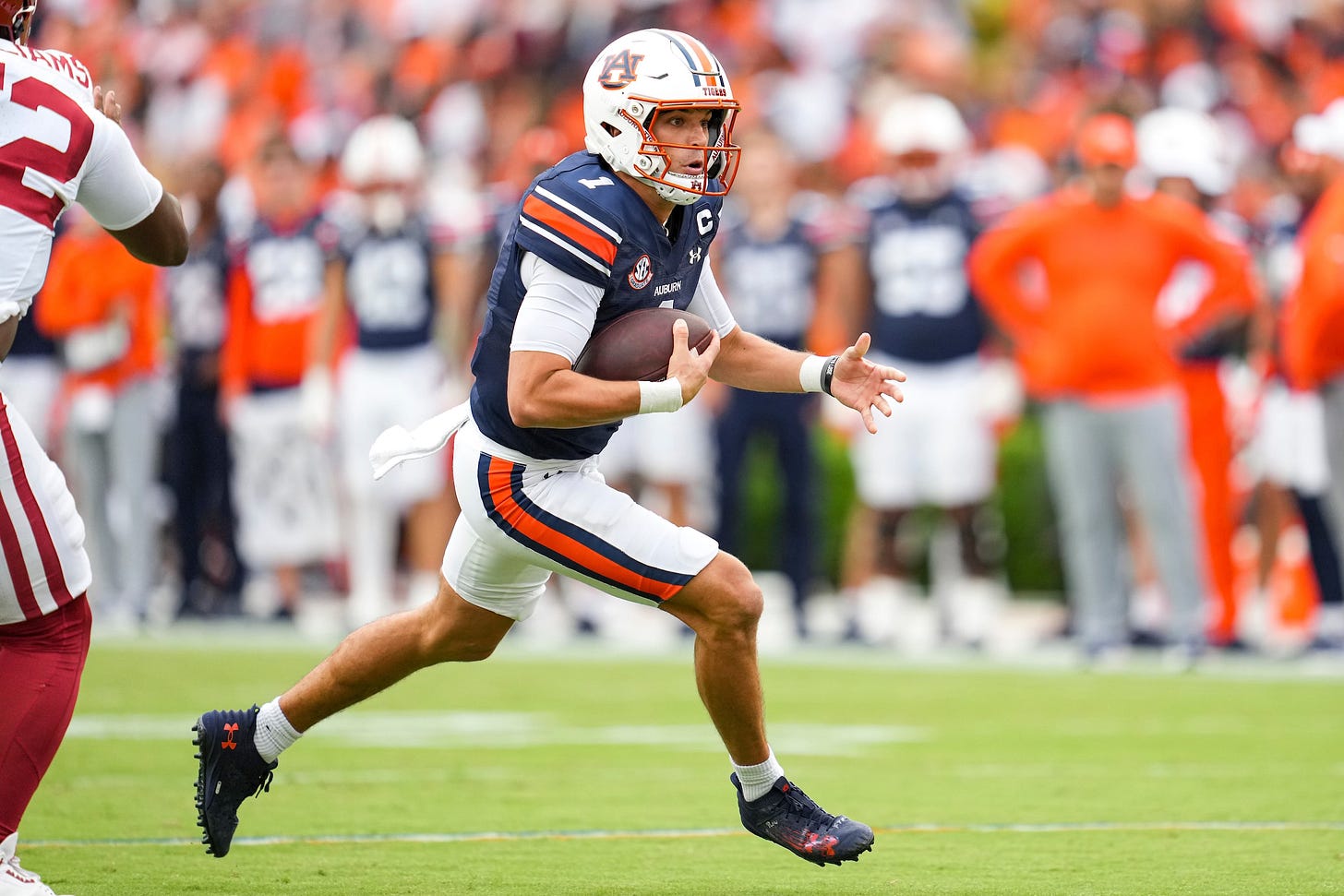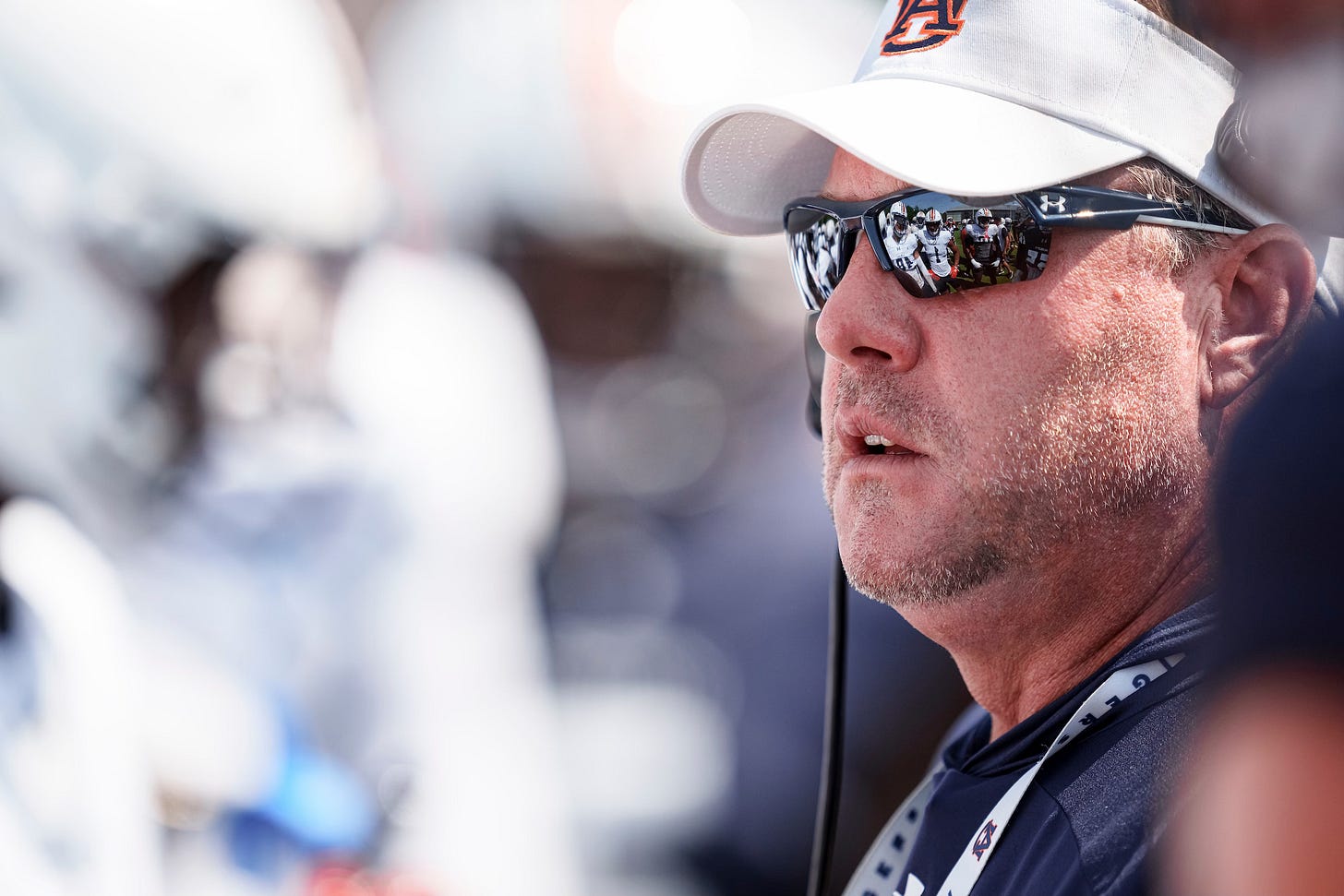Mailbag 183: Can Auburn's offense "progress" to the mean?
This week: Hugh Freeze's ceiling, KeAndre Lambert-Smith, Demarcus Riddick, the UGA trip, uniforms, books and Daniel Day-Lewis
QB Payton Thorne (Austin Perryman/Auburn Tigers)
Did you know there’s no such thing as “progressing” to the mean?
The term for outlier results smoothing out over time is “regression to the mean.” To me, the word “regression” always sounds negative. But, statistically, even positive developments toward the mean counts as “regression.”
So, while it makes sense to ask if Auburn football’s 2024 offense — which is better in explosiveness but severely lacking in scoring — could “progress” to the mean, it’s technically incorrect.
(I promise all of this will matter in just a few paragraphs.)
Here’s the thing: I’m not a stats guy, even though I use them in a lot of my work. I don’t know the formulas or how to come up with them. But I’m a writer, and this is my newsletter. I don’t have a boss here.
So, if I want to ask if Auburn’s offense can “progress” to the mean as the central question to this week’s mailbag, I can do it. The math police aren’t going to come get me.
All that to say, let’s start with an important question facing a 2-3 Auburn football team that is in danger of having its season go sideways after losing three winnable games at home — including an absolutely brutal (and avoidable) one just six days ago:
Does an offense that moves the ball well but can’t consistently put points on the board eventually break through? What do the numbers say about these Tigers?
We’ve got your answers here, along with ones to questions about the ceiling of the Hugh Freeze era, what Auburn can do to get over the hump, what counts as success in this weekend’s trip to Georgia and a whole lot more.
Let’s go.
The conversation on the recap episode this week about Auburn’s success with yardage but failure to score points was interesting to me.
I don’t know that much about football analytics, but in baseball there’s this idea of metrics you can control vs. ones that fluctuate randomly.
So pitchers have a fielding independent pitching stat where it just looks at how good they are at getting strikeouts, limiting walks, and limiting homers, and then balls in play are stripped out because that tends to be noisy and there isn’t necessarily “skill” involved in keeping a batted ball from becoming a hit.
What is the prevailing theory about yardage in football? Is converting yardage into points seen to be a random thing where Auburn should regress to the mean at some point and start scoring more, or is this a repeatable skill that we are bad at?
Trey
Buckle up: You’re about to get a ton of numbers thrown at you in this answer.
To begin, I don’t know if there’s an FIP equivalent in football. While there’s an element of “luck” with turnovers, everything else feels like it’s largely in the offense’s control. Pace of play is the element that gets stripped out the most, which is why it’s better to look at per-play statistics than per-game ones.
But your question about the relationship between yardage and scoring points is a great one, and it sent me down a statistical rabbit hole.
I started by comparing a team’s ranking in offensive yards per play and its ranking in points per game over the last four seasons, including what we have so far in 2024. I focused just on games against power-conference opponents, because there’s usually large and varied gaps in quality in the Group of Five and FCS levels. What’s more important is how an offense performs against its peers.
After subtracting the yards per play rank from the points per game rank for each team, I found that these two metrics are usually close to one another. In 2023, 19 of the top 25 offenses in yards per play ranked within a range of 10 spots in points per game. In 2022, that number was 18. In 2021, that number was 16. The mean, median and mode of these data sets all show a close correlation between the rankings.
If you would like to look at these numbers yourself, here’s a link to the spreadsheet I made to calculate all of this. Each page is sorted by yards per play.
When you look at everybody, the biggest outliers in terms of differential are almost always Group of Five teams that have much smaller sample sizes of power-conference matchups. But there are exceptions, which we’ll get to shortly.
So far in 2024, Auburn is No. 25 in yards per play against power-conference opponents (6.21) and No. 82 in points per game (16.3). That’s a differential of -57, and it’s the largest gap in the entire FBS. Among power-conference teams, Washington is right behind Auburn at -56, followed by Michigan State (-43), Houston (-42) and Arizona (-40).
(By comparison, Auburn was No. 67 in yards per play and No. 61 in points per game last season. Like I said, the rankings are usually quite close for most teams.)
Five games is less than half of the sample size for a whole season, so there’s time for those gaps to get smaller. Again, if you move the ball well against power-conference opponents on a per-play basis, you usually score at comparable rates. However, there have been a handful of negative notable outliers in the power conferences over the last few seasons.
In 2023, Gus Malzahn’s UCF ranked No. 6 nationally in total offense against power-conference opponents but No. 35 in points per game. That gap of -29 was the largest among power-conference teams. UCF went 6-7 and lost three games by 10 or fewer.
This was the theme in the Big 12, where yardage gets put up in bunches — and the real separating factor is finishing drives. Cincinnati, which went 3-9, had a gap of -28. Houston, which went 4-8, had a gap of -25. A 7-6 Iowa State team that lost five close games was at -22. Over in the ACC, Pitt had a gap of -20 and went 3-9.
In 2022, Arizona ranked No. 7 in total offense and No. 34 in scoring in power-conference games. The Wildcats went 5-7. Florida was No. 23 and No. 43, respectively. It went 6-7 and lost five close games under Billy Napier. (As I wrote last week, that feels like the closest parallel to what Auburn is experiencing.) Arizona State had a gap of -18 and went 3-9. Miami had a gap of -18 and went 5-7.
In 2021, TCU was No. 11 in total offense but No. 47 in scoring. The Horned Frogs went 5-7 and fired Gary Patterson. Kansas State survived going No. 17 in yards per play and No. 49 in points per game with an 8-5 record, but it lost three close ones.
Nebraska had the No. 23 total offense and the No. 55 scoring offense in power-conference games, going 3-9 — with all nine losses coming by 10 points or less. (That’s a scary potential parallel season for Auburn.) Louisville lost four close games with a -20 differential that year, and Cal went 5-7 with five close losses at -20 as well.
So, what does all of this mean? While teams who move the ball successfully against power-conference teams usually score at comparable levels, there have been several notable examples of offenses that can’t finish the job and lose close games because of it.
What are the key issues? These teams struggled with turnovers and red-zone efficiency. UCF was No. 92 in turnovers last year. Cincinnati and Houston were tied at No. 96. Pitt was No. 104. Arizona was No. 117 in 2022, with Miami at No. 121. TCU was No. 94 in 2021, and Nebraska was No. 104.
All of these teams ranked 80th or worse in red-zone scoring. Florida was No. 74 in turnovers in 2022 — but No. 102 in red-zone efficiency. The only team I’ve mentioned so far that finished in the top half nationally in turnovers was Cal, which was just above the cutoff at No. 62.
Auburn currently finds itself on track to join these underachieving offenses. Most of them hovered around .500 or had outright losing seasons. What hurts even more for the Tigers is that those offensive issues all came at home, and fixing these problems on the road against some tough defenses in October is no guarantee.
While Auburn can rightfully point to its improvement in moving the ball against quality opponents so far this season, there’s have been several clear-cut examples of offenses that weren’t able to turn those into points over the course of a season.
Those issues turned into missed opportunities, and they did a lot of damage to the final win-loss records. Even if you can move the ball, you can still be an ineffective offense in a frustrating season.
Again, Auburn is a better-looking offense in 2024 compared to 2023. There’s more explosiveness in the passing game with the new wide receivers, and there’s more consistency in the running game overall.
But if the Tigers can’t do a better job of finishing their drives — arguably the most important stat in all of college football — and holding onto the football, those improved per-play numbers can feel like empty progress.
At the end of the day, the main objective is to finish with more points on the scoreboard than the opponent. Against power-conference teams, Auburn is currently 0-3 in that department.
HC Hugh Freeze (Austin Perryman/Auburn Tigers)
Well, for the third straight week, I hated the game recap podcast, but that's not your fault. You and Dan were excellent as usual.
You and Dan made a good point that if the game stopped at 49 minutes, it would have been Freeze's best game at Auburn. But were those 49 minutes really that good? Sure, at this point, I'd be thrilled with any win, let alone a win over a ranked team. But, were those 49 minutes the best we can hope from Freeze's tenure?
The team only scored 21 points at home with a fifth-year senior. There were terrible coaching blunders in those first 49 minutes (Sam Jackson at the 1, the halftime field goal mismanagement). Thorne played better, but he still had one or two near interceptions, and there were several times he had a complete miscommunication with his receivers. And the defense still had a number of missed tackles.
It's encouraging seeing how many underclassmen are playing well, and I'm hopeful about our 2025 class. I also know that Oklahoma is a good team. But if those 49 minutes are the best Freeze can manage, then I'm discouraged.
Wolf
First of all, there’s a huge difference between “Freeze’s best game at Auburn” and “the best (you) can hope from Freeze’s tenure.”



